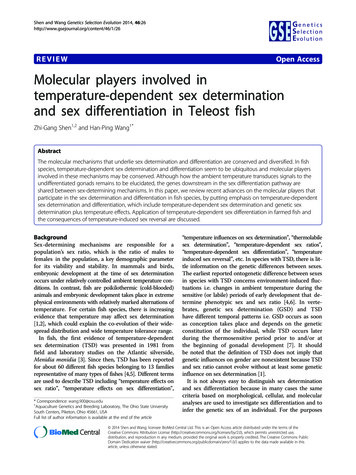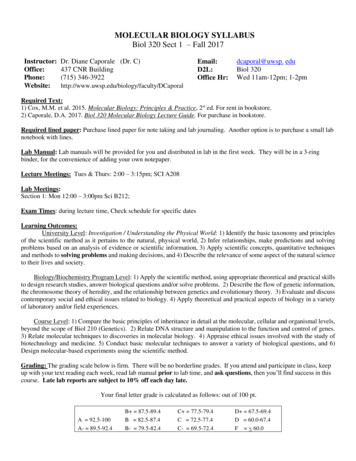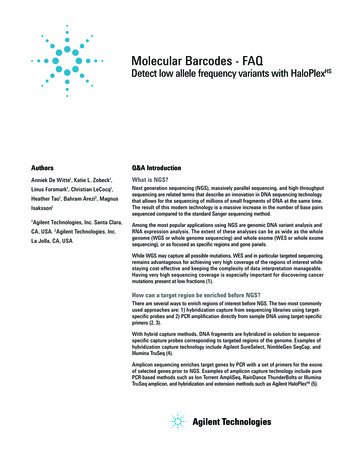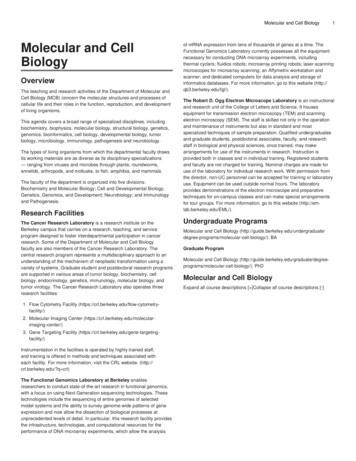
Transcription
Shen and Wang Genetics Selection Evolution 2014, EWGe n e t i c sSe l e c t i o nEv o l u t i o nOpen AccessMolecular players involved intemperature-dependent sex determinationand sex differentiation in Teleost fishZhi-Gang Shen1,2 and Han-Ping Wang1*AbstractThe molecular mechanisms that underlie sex determination and differentiation are conserved and diversified. In fishspecies, temperature-dependent sex determination and differentiation seem to be ubiquitous and molecular playersinvolved in these mechanisms may be conserved. Although how the ambient temperature transduces signals to theundifferentiated gonads remains to be elucidated, the genes downstream in the sex differentiation pathway areshared between sex-determining mechanisms. In this paper, we review recent advances on the molecular players thatparticipate in the sex determination and differentiation in fish species, by putting emphasis on temperature-dependentsex determination and differentiation, which include temperature-dependent sex determination and genetic sexdetermination plus temperature effects. Application of temperature-dependent sex differentiation in farmed fish andthe consequences of temperature-induced sex reversal are discussed.BackgroundSex-determining mechanisms are responsible for apopulation’s sex ratio, which is the ratio of males tofemales in the population, a key demographic parameterfor its viability and stability. In mammals and birds,embryonic development at the time of sex determinationoccurs under relatively controlled ambient temperature conditions. In contrast, fish are poikilothermic (cold-blooded)animals and embryonic development takes place in extremephysical environments with relatively marked alternations oftemperature. For certain fish species, there is increasingevidence that temperature may affect sex determination[1,2], which could explain the co-evolution of their widespread distribution and wide temperature tolerance range.In fish, the first evidence of temperature-dependentsex determination (TSD) was presented in 1981 fromfield and laboratory studies on the Atlantic silverside,Menidia menidia [3]. Since then, TSD has been reportedfor about 60 different fish species belonging to 13 familiesrepresentative of many types of fishes [4,5]. Different termsare used to describe TSD including “temperature effects onsex ratio”, “temperature effects on sex differentiation”,* Correspondence: wang.900@osu.edu1Aquaculture Genetics and Breeding Laboratory, The Ohio State UniversitySouth Centers, Piketon, Ohio 45661, USAFull list of author information is available at the end of the article“temperature influences on sex determination”, “thermolabilesex determination”, “temperature-dependent sex ratios”,“temperature-dependent sex differentiation”, “temperatureinduced sex reversal”, etc. In species with TSD, there is little information on the genetic differences between sexes.The earliest reported ontogenetic difference between sexesin species with TSD concerns environment-induced fluctuations i.e. changes in ambient temperature during thesensitive (or labile) periods of early development that determine phenotypic sex and sex ratio [4,6]. In vertebrates, genetic sex determination (GSD) and TSDhave different temporal patterns i.e. GSD occurs as soonas conception takes place and depends on the geneticconstitution of the individual, while TSD occurs laterduring the thermosensitive period prior to and/or atthe beginning of gonadal development [7]. It shouldbe noted that the definition of TSD does not imply thatgenetic influences on gender are nonexistent because TSDand sex ratio cannot evolve without at least some geneticinfluence on sex determination [1].It is not always easy to distinguish sex determinationand sex differentiation because in many cases the samecriteria based on morphological, cellular, and molecularanalyses are used to investigate sex differentiation and toinfer the genetic sex of an individual. For the purposes 2014 Shen and Wang; licensee BioMed Central Ltd. This is an Open Access article distributed under the terms of theCreative Commons Attribution License (http://creativecommons.org/licenses/by/2.0), which permits unrestricted use,distribution, and reproduction in any medium, provided the original work is properly credited. The Creative Commons PublicDomain Dedication waiver ) applies to the data made available in thisarticle, unless otherwise stated.
Shen and Wang Genetics Selection Evolution 2014, 46:26http://www.gsejournal.org/content/46/1/26of this review, sex determination is used to describe thegenetic and environmental processes and variables thatinfluence sex differentiation, while sex differentiation isused to indicate the physical realization of these eventsin terms of testicular or ovarian development. Thedefinition of TSD originates from studies on reptiles(lizards and turtles), in which sex differentiation andthe thermosensitive period (TSP) occur during theembryogenetic period (incubation) [8-10]. In contrast, infish species, sex differentiation occurs during the postembryonic period of larval development (post-hatching).Therefore, the criteria that are used to identify TSDin reptiles cannot be applied in fish. The criteria fordistinguishing GSD, TSD and GSD TE (GSD plustemperature effects) have been extensively discussedby Valenzuela et al. [6] and Ospina-Álvarez and Piferrer[4]. According to the criteria of Ospina-Álvarez andPiferrer [4], only 40 of the 59 fish species for whichTSD was claimed on the basis of laboratory and/orfield data could be classified as species with TSD,which suggests that TSD is less common than initiallythought. In other words, based on their criteria, the sexdetermining mechanism of about one third of the fish species that were thought to have TSD may have GSD TE.Such studies are challenging because they require knowledge on the conditions that are normally encountered inthe wild by a particular species or population duringthe sensitive period of development. Moreover, experimental designs that are aimed at distinguishing betweenTSD from GSD TE by mimicking natural temperaturefluctuations can be difficult to carry out because extremeconditions may simply alter the process of sex differentiation in a species with GSD only and yield skewed sex ratios [11]. Temperature effects on the sex ratio during thethermosensitive period in a fish species that is claimed tohave TSD, should occur as an inheritable trait, i.e. its analysis at the population level should reveal an evolutionarypattern rather than an occasional pattern. However, negative results from studies that test a population for TSD mayonly reflect the status of a particular geographic populationand not the species as a whole, because TSD in fish frequently involves genotype by temperature interactionwith strong parental effects on family sex ratio. Indeed, in Atlantic silverside and other fish species,temperature sensitive and insensitive populations that occupy different locations have been observed [1]. In addition,we reported in the bluegill sunfish Lepomis macrochirus theexistence of two contrasted temperature-sensitive populations (in which the proportion of males increased with either increasing or decreasing temperature) as well astemperature insensitive populations ([12] and personalcommunication).As sex-determining mechanisms, TSD and GSD shouldbe considered in an equivalent manner [13], which leadsPage 2 of 21to reconsider the status of fish species that are claimed tohave TSD when submitted to extreme temperaturesinstead of the temperature experienced during developmentin the wild since changes in sex ratio with temperaturevariation are ecologically and evolutionally relevant.Furthermore, in zebrafish (Danio rerio), it was found thathypoxia can affect sex differentiation and sex developmentalong with down-regulations of various genes that controlthe synthesis of sex hormones and the increase of thetestosterone/estradiol ratio, thus producing male-skewedpopulation versus normoxic groups [14]. It was also shownthat hypoxia disrupts primordial germ cell migrationduring embryonic development through the inductionof insulin-like growth factor binding proteins in zebrafishembryos [15,16] and in the Atlantic croaker Micropogoniasundulates after exposure to natural or laboratory hypoxia[17]. Taken together these results suggest that, in somecases, hypoxia rather than extreme high temperatures maycontribute to variation in sex ratio since high temperatureis considered to decrease the relative water oxygen solubility and may result in hypoxia [18]. These factors will needto be taken into account in future studies.TSD is said to occur when the water temperatureexperienced by the offspring irreversibly determines itsprimary sex [19]. GSD occurs when primary sex isdetermined by the genotype at conception and isthereafter independent of environmental conditions.How and why transitions between TSD and GSDoccur are two key questions about the evolution ofTSD. Most of the hypotheses formulated to explainthe evolution of TSD are adaptive, but neutral orquasi-neutral alternatives have also been proposed [7](Figure 1). For example, in the Atlantic silverside, TSD isgeography-dependent. In this species, female-biasedpopulations are produced in the early spawning periodwhile male-biased populations are produced later and thechange in sex ratio with temperature is greater at lowlatitudes where the breeding and growing seasons arelonger than at high latitudes where the breeding andgrowing seasons are comparatively short [1]. TSD isadaptive in this fish species because the longer growingseason afforded to the female fish allows them toreach a larger size by the time breeding occurs, and asize advantage is more favorable to females than tomales [20]. Hence, in Atlantic silverside, both extremenorthern and extreme southern populations are GSD(without TSD), while intermediate populations show themaximum level of sex ratio response to temperature(with TSD).In Menidia, it has been shown that TSD is a highlyevolved trait that responds rapidly to selection rather thanmerely the plasticity of a primitive sex-determining mechanism [1]. Schwanz et al. [21] proposed that evolutionarytransitions from GSD to TSD (with no sex chromosomes)
Shen and Wang Genetics Selection Evolution 2014, 46:26http://www.gsejournal.org/content/46/1/26Page 3 of 21Figure 1 Transitions between genetic sex determination (GSD) and temperature-dependent sex determination (TSD). The way thesex-determining (SD) modes are presented does not indicate ancestral states. GSD TE, genetic sex determination plus temperature effects. Thedata presented are a compilation from Valenzuela [204].can occur rapidly and readily through the acquisition ofthermosensitivity by selection for TSD without crossing afitness valley, which was first described by Bull [19,22].Evolutionary transitions from TSD to GSD are alsoconsidered as simple and straightforward [23,24].Surprisingly, both TSD and GSD have evolved multipletimes in the course of vertebrate history via a parsimonybased statistical framework [25]. It was shown that TSDwas lost at least six times in turtles and arose at least threetimes in lizards [25]. Accordingly, since both GSD andTSD have been “lost” and “found” numerous times invertebrates, the phylogenetic lability of sex-determiningmechanisms is extraordinary, which agrees with theabove-mentioned hypothesis on transitions between TSDand GSD.An important aspect to be taken into account isthat regardless of whether one species has TSD orGSD (or GSD TE), under certain circumstances (e.g.under extraordinary natural conditions or whenmoved to laboratory conditions), fish can respond totemperature changes, which leads to skewed sexratios. Such effects of the temperature on sex ratiosapparently involve the same downstream signalingpathways as TSD. It is possible that, in fish, somesteps of the pathways involved in TSD and GSD aresimilar. Independently of whether sex determinationis pure TSD or GSD TE, it is clear that fish offer anexcellent model to explore the plasticity of the mechanisms of sex determination and sex differentiation.Our aim is to standardize the criteria that distinguishTSD and GSD TE by pooling the data of TSD andGSD TE together and review the molecular players thatunderlie the temperature effects in sex determinationand differentiation.ReviewPutative molecular pathways involved in TSD and GSD TEInvestigating the genes that are involved in TSD isinteresting but information is scarce, even in reptiles.So far, only a few candidate genes associated withtemperature-induced sex reversal were studied in fishspecies. It is assumed that the thermal master switch,which triggers the undifferentiated gonads to followthe male or female pathway, will be the gene(s) thatactivate the thermosensitive period (TSP) or specifyresponses during this developmental time window.Candidates for this role would be genes that areexpressed prior to, or exactly at, the onset of the TSP,rather than genes that are differentially expressedafter TSP activation [26]. Two such potential masterswitch genes, the sf-1 and wt-1 genes that are involved inthe formation of a bipotential gonad, have been proposedon the basis of their early significant differential expressionbefore the onset of the TSP in reptiles with TSD. Othergenes that have been proposed are sox9, sox8, fgf9,amh (mis) and dmrt1 that are associated with thetestis-determining pathway, dax1 and wnt4 that areinvolved in intersecting pathways and foxl2 and rspo1that determine the ovarian pathway [27-30]. To ourknowledge, none of these genes have been reportedto be responsible for TSD or to be direct targets oftemperature-dependent sex differentiation in fish. Inthis article, first we review the genes that are knownto play a role in GSD, and then the genes that areexpressed downstream in the sex determination cascadeand involved in TSD and GSD TE and in the putativemechanisms that underlie the effect of temperatureon sex differentiation. The cortisol-mediated pathway andepigenetic regulatory pathway are also summarized. Our
Shen and Wang Genetics Selection Evolution 2014, 46:26http://www.gsejournal.org/content/46/1/26aim is to propose a review of the literature on the mastergenes involved in TSD to stimulate future investigations.Major sex-determining genes involved in GSDThe dmy geneThe dmy gene is a master sex-determining gene thatwas first described in 2002 in the medaka, Oryziaslatipes, which has an XX/XY (female homogamety)sex-determining system [31,32]. It is an excellent candidateas a primary male determining gene equivalent to the srygene of mammals. The gene, designated dmy [31] ordmrt1Y [32], was located in the Y-specific chromosomalregion that contains the male determining gene. It isimportant to note that this is the only structural gene,which specifies a functional protein in the Y-specificchromosome region [32,33]. The product of this genecontains a DNA-binding domain called the DM domain, astructural motif present in a family of genes that is foundin a wide range of invertebrates and vertebrates fromnematodes and flies to humans [34-37]. The dmy/dmrt1Ygene is assumed to have arisen from a recent duplicationevent (5 to 10 million years ago) of the autosomal dmrt1gene [33,38]. A fragment of the medaka linkage group 9that contains the dmrt1 gene was duplicated andinserted into the chromosome of linkage group 1, whichsubsequently became the Y chromosome [39].The dmy gene is expressed before the sex-determiningperiod, specifically, before the first appearance of morphological sex differences at the hatching stage when the maleexhibits a decreased number of primordial germ cells [39].The level of expression of the dmy gene during the sexdetermining period appears to be critical for its function,since mutants that do not express this gene fail to becomemales and develop as sex-reversed XY females [31,40]. Insex-reversed XY females induced by estrogen treatment,the dmy gene is expressed in the ovaries at a level similar tothat in the testes, which means that the expression of thisgene is not affected by the administration of exogenousestrogen [32]. Furthermore, the early expression ofdmy in the somatic cells of the undifferentiated gonadis not influenced by 17β-estradiol (E2, natural estrogen)treatment [41]. In addition, a high-temperature treatment(above 27 C) during the sex-determining period failsto induce expression of dmy although it leads to themasculinization of medaka XX females [42]. In summary,the expression of dmy is in perfect agreement with itsfunction as a male upstream determining gene in medaka.Two distinct natural mutations in the dmy gene presentin wild medaka populations have been shown to induce XYgenotypes to become fertile females [31]. A subsequentinvestigation on a natural mutant of medaka fry alsoshowed an increased number of germ cells at day 0post-hatching due to the low expression of dmy, withfry developing into females [40]. A gene knockdownPage 4 of 21experiment that used gripNA antisense oligonucleotides directed against dmy transcripts also showedthat dmy knockdown XY medaka fry and control XXfemales had comparable germ cell numbers, whichindicates that the disruption of the dmy gene resultedin the gonads entering the female pathway [43]. Thus,the dmy gene is necessary for the development ofmales in medaka. Moreover, over-expression of dmy byinjecting dmy genomic DNA fragment into XX femaleeggs or over-expression of the dmy cDNA under thecontrol of the CMV promoter in XX females resulted inXX individuals developing into males [44]. These resultsindicate that expression of dmy may be sufficient toinduce male development in XX females.Collectively, these results suggest that the dmy gene isa good candidate male determining gene at least in someof strains of medaka and its relative species Oryziascurvinotus [37,40]. In terms of temperature effects onsex determination and differentiation, it is not yetknown whether temperature can affect the expression ofdmy [42] (see next section) although high-temperaturetreatments during the early stages of development resultin females having a male phenotype. It is interestingto note that the thermosensitive period of sex differentiation in medaka lies between developmental stages 5 to 6(8 to 16 cells) and 36 (heart development stage) [42], whichis just before expression of dmy begins (stage 36). It isassumed that the function of dmy in the male embryoduring the sex-determining period is to control theproliferation of primordial germ cells [39]. Likewise,Selim et al. [45] observed that a high-temperaturetreatment before hatching inhibited the proliferationof germ cells and the development of oocytes andconsequently resulted in sex reversal. The fact thatdmy and temperature have the same effects on theproliferation of primordial germ cells, and that genotypic(XY) males and genotypic (XX) females possess adimorphic sensitive pattern to temperature during TSP[42] show that temperature may play a pivotal role infemale fate as does dmy in male fate during evolution.These reports also suggest that genetic as well as environmental factors are not incompatible in terms of effects onsex determination or differentiation with the existenceof genotype by environment interactions, as alreadymentioned in fish species and reptiles [1,4,46,47]. Tounderstand the interaction between the sex-determininggene (dmy) and the environment factor (temperature), theeffects of temperature on the expression of dmy and itsdownstream targets should be investigated further.The amhy, gsdf, amhr2, and sdY genesJust prior to and during the preparation of the presentreview, four additional strong candidate master sexdetermining (SD) genes were reported in fish, which
Shen and Wang Genetics Selection Evolution 2014, cates that this area of study is moving fast. Theseinclude the genes amhy in Patagonian pejerrey Odontestheshatchery [48], gsdf in Oryzias luzonensis [49], amhr2 infugu (tiger pufferfish) Takifugu rubripes [50], and sdY inrainbow trout Oncorhynchus mykiss [51]. All master SDgenes reported to date are in Figure 2, which also includesthe mammalian sry gene, the dmrt1 gene in birds, theDM-W gene in Xenopus laevis, and the dmy gene inmedaka O. latipes.These novel master SD genes highlight the importanceof non-transcriptional factors in sex determination sincethree of these genes i.e. amhy, amhr2 and gsdf areinvolved in the TGF-β signaling pathway, while the sry,dmrt1, DM-W and dmy genes code for transcriptionfactors (Figure 2). In mammals, the TGF-β signalingpathway has been shown to play important roles in thedevelopment of ovarian and testicular functions [52,53]but there is no evidence that it may be involved insex reversal. Nevertheless, the identification of thethree SD genes amhy, amhr2, and gsdf [48-50] indicatesthat the TGF-β signaling pathway plays a critical role in thecommitment to the fate of either testicular or ovariandevelopment. It has been hypothesized that this pathway may have a more dominant role in gonadal sexdetermination in non-mammalian vertebrates than inmammals [54]. For example, while amh clearly lies fardownstream in the sex determination pathway and iscontrolled by sox9, it has been shown in chicken thatthe expression of amh precedes that of sox9 in males[55,56]. In the American alligator, in which TSD ispresent, expression of amh precedes the onset of sox9expression during testis differentiation [57]. AnalysisPage 5 of 21of the expression patterns of sox9a, sox9b and sox8compared to that of amh in different cell types ruledout the hypothesis that amh is regulated directly bysox9 or sox8 at least in the granulosa cells of adultzebrafish ovaries [58]. These findings combined with theaforementioned results in different fish species corroborateor confirm this hypothesis.To date, one of the four novel SD genes, sdY, which isa truncated, divergent form of the immune-related geneirf9 [51], has not been reported in the literature unlikethe three others, which have been characterized andshown to play important conserved roles in the gonadaldifferentiation pathway across vertebrates. The sdY gene,which is expressed in the somatic cells that surround thegerm cells, encodes a novel protein that displayssequence homology with the carboxy-terminal domainof irf9 [51]. IRF9 is a transcription regulatory factor thatmediates signaling by type I interferon in mammals [59].The sdY sequence is highly conserved in all salmonids andis a male specific Y-chromosome gene in the majority ofthese species except in two whitefish species (subfamilyCoregoninae) [60]. These results indicate that most salmonids share a conserved master sex-determining geneand that an alternative sex-determining system mayhave also evolved in this family. For more details, refer toKikuchi and Hamaguchi [61].Growing evidence demonstrates that the sex-determiningpathways in fish species are conserved and diverse (Figure 2,see O. latipes and O. luzonensis). The dmy in O. latipes andgsdf genes in O. luzonensis (a close relative of O. latipes) areestimated to have appeared about 10 and 5 million yearsago, respectively [49]. It is very interesting to note that theFigure 2 An overview of master sex-determining genes in mammals, birds and fish. The phylogeny is a compilation from Kikuchi and Hamaguchi[61]. SD: sex determination; TGF-β, transforming growth factor β; sox9: SRY-like HMG-box containing transcription factor 9 gene; amh: anti-Müllerian hormonegene (also known as mis, Müllerian-inhibiting substance gene); dmy: Y-specific DM-domain gene 9 (dmrt1Y) [31,32,48-51,213-220].
Shen and Wang Genetics Selection Evolution 2014, ession of the gsdfY gene can lead to a male phenotypein XX medaka O. latipes in the absence of dmy expression.The gsdfY gene is located downstream to dmy in O. latipesand originates from gsdf [49], which means that, at present,it functions independently of the existing sex-determininggene, and has usurped the control of the downstreamcascade of sex determination within 5 million years.Genetic by environment interactions are a hot topic.Nevertheless, no evidence has shown that temperatureinfluences expression of sex-determining genes duringthe TSP. TSD is claimed in more and more fish species buthow temperature can act as a signal for the undifferentiatedgonad to generate a male or female pathway and what arethe downstream target(s) of most sex-determining genes,remain to be elucidated (Figure 2).Testis-determining genes involved in TSD and GSD TEThe dmrt1 geneThe mechanisms that control sex determination and sexdifferentiation are highly variable among different phyla[62]. However, genes that are located downstream in thesex determination pathway are conserved [63]. Forexample, the dmrt1 gene plays a pivotal role in the fateof gonads in fish, reptiles, birds and mammals, and isexpressed in the developing gonads, or in the adulttestis and/or in the ovary. The dmrt1 gene encodes aputative transcription factor containing a zinc-finger-likeDNA-binding motif (DM domain) and was initially identified in nematodes [64] and flies [34]. This gene is regardedas a crucial regulator of male sexual development frominvertebrates to humans [65] and also as evidence that thesex determination and gonad differentiation mechanismsare conserved across different lineages [35,66,67].The ray-finned fish (Actinopterygii) has two paralogouscopies for many genes (e.g. dmrt1a and dmrt1b, cyp19a1aand cyp19a1b, sox9a and sox9b) due to the hypothesizedfish-specific genome duplication that is dated between 335and 404 million year ago [68]. With the increasingavailability of whole-genome sequences, the comparativeanalysis of genes and genomes will reveal the evolutionand phenotypic diversification of the third round (andfourth round in some fish species such as common carpCyprinus carpio) of genome duplication [69-72]. Someduplicated genes have evolved new functions, while othershave disappeared [71]. In this review, we focus mainly onthe dmrt1 gene among the many duplicated genes that aremostly related to sex determination and differentiationand have been extensively investigated.The most direct evidence for the important role ofthe dmrt1 gene has come from the discovery that thesex-determining gene of medaka, dmy originates froma duplicated copy of the autosomal dmrt1 gene [44].In teleost fish, the expression of dmrt1 is associatedwith temperature effects and displays variable patternsPage 6 of 21in different species (See Additional file 1: Table S1). Intilapia (Oreochromis niloticus) and trout (O. mykiss),dmrt1 is expressed in males prior to sex differentiationbut not in females, which indicates that, in these fishspecies, it is involved in testis formation and differentiation [73-75]. However, in other fish species, like medaka,pejerrey (Odontesthes bonariensis), and European sea bass(Dicentrarchus labrax), sexually dimorphic expression ofdmrt1 in males and females was reported (See Additionalfile 1: Table S1), which indicates that, in these cases, dmrt1participates in testis and ovarian development.Regarding temperature effects on sex ratios, althoughexpression profiles of dmrt1 have been described in alimited number of fish species, the results suggest that itplays an essential function in male development andtestis formation in fish species with TSD or GSD TE.In pejerrey, a fish species with pure TSD (based on thecriteria of Ospina-Álvarez and Piferrer [4]), the abundance of dmrt1 transcripts differed clearly between larvaereared at female producing (or promoting) temperature(FPT, 100% female) and larvae reared at male producingtemperature (MPT, 100% male). The expression of dmrt1was significantly higher at MPT than at FPT duringthe two weeks before the first signs of morphologicaldifferentiation of the testis, and remained high duringsexual differentiation at MPT, which highlights theimportance of dmrt1 during the first stage of the gonadalsex differentiation cascade, rather than during themorphological differentiation of the gonads. However,it is interesting to note that, in larvae reared at FPT,dmrt1 expression remained low throughout the experiment (See Additional file 1: Table S1), which opens thequestion on the function of dmrt1 in ovarian developmentin pejerrey [76]. Similar results have been reported inreptiles with TSD [30,77-79].In red-eared slider turtle (Trachemys scripta) embryos,expression of dmrt1 in the gonads is up-regulated with alarge difference between embryos reared at FPT and atMPT, which indicates that dmrt1 is necessary formale development [80]. In addition, if the eggshells ofdeveloping T. scripta embryos are treated with estrogenbefore the thermosensitive period, dmrt1 expression isinhibited during this period [81]. Suzuki et al. [41] alsofound that the level of dmrt1 expression is very low(even undetectable) in testes treated with 17β-estradiol(E2, natural estrogen) compared to control untreatedtestes. In zebrafish, exposure of larvae to environmentallyrelevant concentrations of 17α-ethinylestradiol (EE2,synthetic estrogen) suppresses dmrt1 expression duringgonad differentiation [82]. To our knowledge, there isno evidence on the possible implication of exogenousestrogen treatment on dmrt1 expression in the inductionof sex reversal in fish species with TSD. Taken together,these data strongly indicate that dmrt1 is involved in testis
Shen and Wang Genetics Selection Evolution 2014, ation and differentiation, and that its expression issensitive to both temperature and estrogen in turtles withTSD and fish species
Zhi-Gang Shen1,2 and Han-Ping Wang1* Abstract The molecular mechanisms that underlie sex determination and differentiation are conserved and diversified. In fish species, temperature-dependent sex determination and differentiation seem to be ubiquitous and molecular players involved in these mechanisms may be conserved.










